|
Michael McFadyen's Scuba Diving - Grumman Hellcat
In the late 1930s and right up to the start of World War II, the Japanese had far superior aircraft to the United States and the Allies. This meant that their initial actions overpowered the Allies, with the Zeros and other aircraft outflying the American, Australian and New Zealand planes. However, it was not long before the Americans started turning out aircraft that equalled or even out performed the Japanese planes.
Based on the Grumman F4F Wildcat, a new plane was designed by the Grumman Aircraft Engineering Corporation in early 1942 and the prototype first plane flew in August 1942. This was the Grumman F6F Hellcat and by the end of 1944 over 8,500 had been built. A total of 12,272 were built in all. The Hellcat had a wingspan of 13.05 metres, length of 10.2 metres and typically weighed 6,000 kilograms fully loaded. It was powered by a 2,000 hp (after January 1944 2,200 hp) Pratt & Whitney R-2800-10 (after 1944 R-2800-10 W) Double Wasp 18 cylinder two-row radial engine with a three blade Hamilton Standard Hydromatic propeller. Maximum speed was over 640 km/h with a range of 2,880 kilometres. Armament was six 0.5 inch Browning machine guns with 400 rounds each. There were underwing attachments for six rockets and centre pylons for 2,000 lb of bombs. The plane was aluminium with fabric-covered flaps and tail.
On 26 June 1943 a Grumman F6F-3 Hellcat, serial number 25389, manufacturer number A553, was delivered to the US Marines from the Grumman factory at Bethpage, Long Island, New York. It was one of 4,402 planes of this version. On 10 July 1943 the plane was delivered to SD Pac and on 14 July 1943 it arrived at Noumea, New Caledonia. On 13 September 1943 the plane was allocated to VF 38 based at Fighter One, Guadalcanal, British Solomon Islands.
Richard "Dick" Moore grew up in La Grande, Oregon. He did a civil pilot's course at East Oregon State College and joined the US Naval Aviator Corps on 19 November 1941. He trained at Corpus Christi in Texas and did his carrier landing at Chicago, Illinois. He then spent three months at Alameda, California before serving on a carrier in Attu, Alaska and in August 1943 he moved to the South Pacific.
On 29 January 1943, Lt Jnr Dick Moore was shot down over the Munda area of the Solomon Islands and on 31 January 1943 he shot down three Mitsubishi A6M Zeke "Zero" fighters, two bi-planes and crashed off Kolombangara Island. He was rescued by natives and was awarded the Medal of Honour for this feat (the kills, not the crash).
Sometime after this, the Grumman F5F-3 Hellcat serial 25389 was allocated to Lt Dick Moore. He named it "Betsy II" after his wife, Betty.
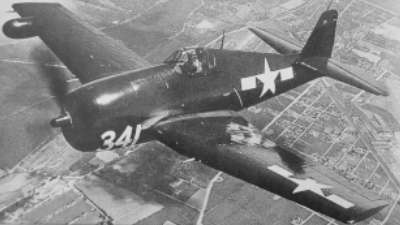 | 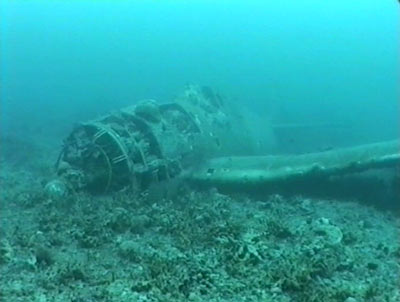 |
| Grumman F6F-3 Hellcat | The front of the Grumman F6F-3 Hellcat
Photo from Hi-8 video |
At 1315 on 16 September 1943, Fighter Squadron VF38 based at Fighter One on Guadalcanal, left Munda airfield for Ballale Island. Ballale Island is between Bougainville in Papua New Guinea and the Shortland Islands. The planes were over the target area 1145 to 1435. The planes were to provide low level cover for 24 Grumman TBF Avenger torpedo bombers and 31 Douglas SBD Dauntless dive bombers. There were 13 Hellcats of VF38, 11 Hellcats of VF40, other Hellcats, Chance Vought F4U Corsairs, Curtis P40 Warhawks and Lockheed P-38 Lightnings, a total of 71 support planes in all.
They ran into 40 to 50 Japanese planes, mostly Zeros but with also some Kawasaki Ki-61 Hien "Tony" fighters. There was also anti-aircraft fire up to 12,000 to 13,000 feet from the Shortland and Bougainville Islands. The planes fought a fierce battle from 13,000 feet right down to 400 feet.
During the battle, three Zeros were shot down with one probable and one possible kill. Three Hellcats were shot down and one Hellcat flown by Lt Wayne Riley, USNR, was missing in action. Another made it to Munda damaged.
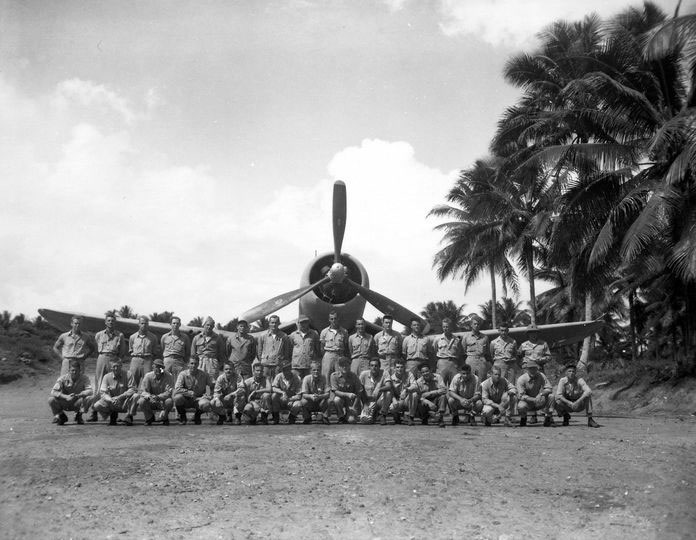 |
| Pappy Boyington and the Black Sheep in front of a F4U Corsair - VMF-214 at Turtle Bay fighter airfield on Espiritu Santo, September 1943 |
Lt Moore was flying when he was attacked by what he at first thought was a Zero. However, it soon became obvious to him that it was in fact a F4U Corsair. The pilot of this plane was Major Gregory "Pappy" Boyington, one of the highest scoring aces of World War II. Boyington was a member of the famous "Flying Tigers" who flew in the China area of the War (remember the John Wayne movie?). He later commanded a group in the Pacific which gained the name "Black Sheep", later made famous in the TV show "Baa Baa Black Sheep".
Anyway, Boyington attacked at a distance of 100 yards and hit the Hellcat at least twice, one behind the cockpit and once high on the port side of the engine (there appears to be two obvious hits on the plane, one at the front bottom of the tail and once behind the cockpit). The Hellcat sprung an oil leak (not from the oil tank as the armoured tank is intact). Moore fired a warning shot back at Boyington and this appears to have stopped the attack. Since the plane was definitely hit in the engine, it seems it was hit by at least three of Boyington's bullets.
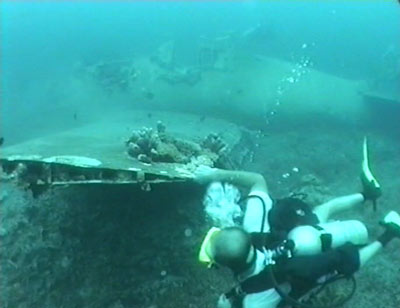 | 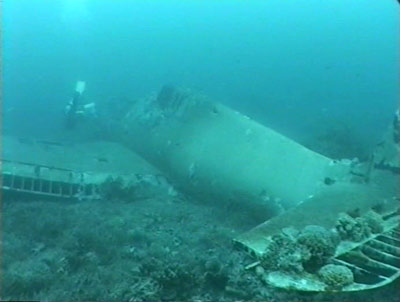 |
Andreas Thimm and the port wing Grumman Hellcat
Photo from Hi-8 video | A shot from the rear port side
clearly showing flaps fully extended
Photo from Hi-8 video |
The Hellcat was leaking oil and this caused smoke to come from the engine. The loss of oil was obviously going to eventually cause the engine to seize so Moore nursed his plane all the way from Bellale Island back to the area to the north-west of Gizo. When three kilometres south of Kolombangara Island in Blackett Strait, Moore landed his plane in the ocean, presumably after the engine seized or started to seize. Flaps fully down and in a full stall, this was a perfect landing. The time was 1530. Moore climbed onto the wing, inflated his life jacket and raft. The plane was reported as being about 100 feet from a reef. It was located between Blackett Strait and Vonavona Lagoon, between three small islets and near Queue Island. Perhaps this is how Boyington became an Ace - shooting down US planes!
Before Moore could get into his raft, a canoe with 15 natives arrived and they attempted to get him to get into their canoe. Another canoe arrived with 6 natives and a Private Nash from the US Army. Moore got into one of the canoes and was taken to an island where Lt Reg Evans of the Royal Australian Navy (RANVR) was based as a Coastwatcher (Evans also rescued President John F. Kennedy and his crew when his patrol boat was sunk).
Evans gave Moore dry clothes, a cup of tea and lime-ade. He sent Moore in a canoe to another island (time was now 1630) and at 0800 on the next morning, 17 September 1943, Moore arrived at Munda, about 20 kilometres away. By 1030 he was back at Fighter One on Guadalcanal.
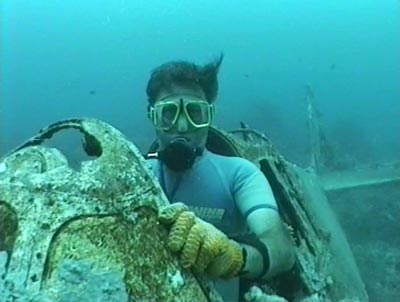 |
Me sitting in cockpit of the Grumman Hellcat
Photo from Hi-8 video |
Dick Moore also crashed in August 1945 near Japan but was rescued by a destroyer.
In 1985, Danny Kennedy, owner of Adventure Sports, found the wreck of the Hellcat. Today it lies in about 11 metres of water, in a cleared patch of coral. The plane faces south and appears to be fully intact. The starboard wing is mostly buried in coral. The flaps are fully down and the cockpit open. All the instruments appear to be still there and you can read the serial number of the plane quite easily.
When I dived it, we were asked to replace some 0.50 inch rounds stolen from the plane a week earlier by a group of Sydney divers. The ammunition magazines are open, the covers ripped off by divers over the years. As I indicated above, the plane has two obvious bullet holes, one in the front of the tail and one behind the cockpit. The engine cover is missing and you can see the oil tank, with its armoured cover providing protection from the front. There does not appear to be any hole in the tank so it would appear an oil line was hit.
If you remove your tank and BCD, you can sit in the plane's cockpit.
This dive is down normally as a third dive using the remains of your second tank. A very nice little dive, worth 20 minutes or so. Visibility was about 15 metres or so.
Dives:
18 October 2001
References:
| 
 v6.00.307 © 2003-2005
v6.00.307 © 2003-2005